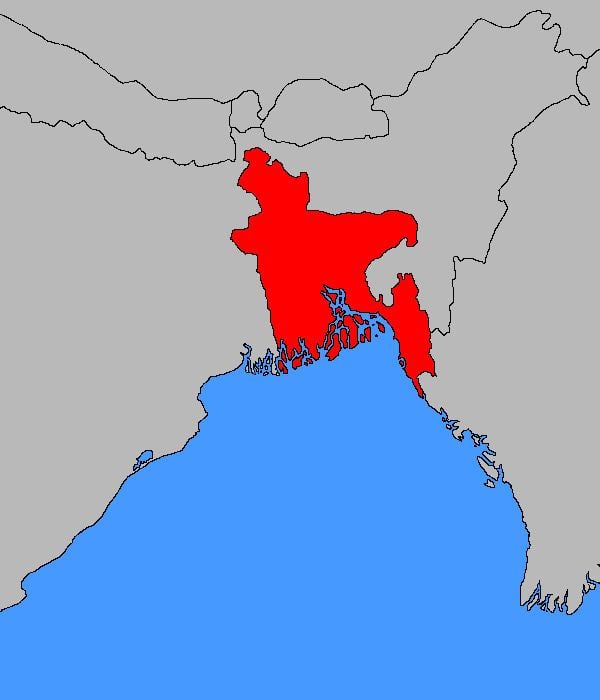Capital Dacca 1950–1953 Sir Feroz Khan Noon | Religion Islam
Hinduism | |
 | ||
Languages Bengali (official)
English Government Constitutional Monarchy 1947–1950 Sir Frederick Chalmers Bourne | ||
East Bengal (Bengali: পূর্ব বাংলা Purbô Bangla) was the name used during two periods in the 20th century for a territory that roughly corresponded to the modern state of Bangladesh. Both instances involved a violent partition of Bengal which made one half East Bengal or Bangladesh and the other today's Indian state of West Bengal.
Contents
- First partition 19051912 British period
- Second partition 19471971 Pakistani period
- Provincial government
- References
The area compromises roughly two-thirds of the ethno-linguistic region of Bengal.
First partition, 1905–1912 (British period)
The first instance of the name was during the British rule of India. British governance of large swathes of Indian territory began with Robert Clive's victory over the Nawab of Bengal, Siraj ud-Daulah, at the Battle of Plassey in 1757. The victory gave the British East India Company dominion over Bengal, which became the headquarters of British administration in the sub-continent. After the Indian rebellion of 1857 (known as the "Mutiny"), the British government took direct control away from the East India Co., and established its imperial capital at Calcutta, the city founded by the Company. By 1900, the British province of Bengal constituted a huge territory, stretching from the Burmese border to deep into the Ganges valley.
With the assumption of Lord Curzon to the office of Viceroy of India, British India was finally put under the charge of a man who considered himself an expert in Indian affairs. Curzon, seeing the logistical problems of administering such a large province, proposed to divide Bengal. Bengal, henceforth, would encompass Calcutta and the western territories, roughly comprising modern West Bengal, Bihar, Jharkhand, and Orissa. Eastern Bengal and Assam, the new province, would roughly encompass modern Bangladesh and the northeastern states of India (then all grouped under the heading of Assam, with its capital at Dacca (Dhaka)).
While Curzon claimed the action was one merely founded upon administrative principles, the growing nationalist movement, which originated with the educated elite of Calcutta and the Bengali aristocracy, took the action as an attempt to cut off Bengal's Hindu intellectual leaders (based in Calcutta) from the majority Muslim agriculturalists of the east, dividing the nationalist movement along lines of class and religion. The partition of Bengal, effected in July 1905, sparked a firestorm in the nationalist movement. The partition was revoked in 1912, but it was accompanied by slicing off the non-Bengali portions of the province – creating two additional provinces, Assam and Bihar and Orissa (both themselves further subdivided after Indian independence) – and the shifting of the capital from Calcutta to Delhi.
In the now divided Bengal, East Bengal comprised an area of 196,540 square miles (509,000 km2) that included 18 million Muslims and 12 million Hindus. The (old) Bengal area had 141,580 square miles (366,700 km2) with a majority of 42 million Hindus and 9 million Muslims.
Second partition, 1947–1971 (Pakistani period)
Bengal was divided into two provinces on 3 July 1946 in preparation for the partition of India - the Muslim-majority East Bengal and the Hindu-majority West Bengal. The two provinces each had their own Chief Minister. In August 1947, West Bengal became part of India, and East Bengal became part of Pakistan. Tensions between East Bengal and the western wing of Pakistan led to the One Unit policy. In 1955, most of the western wing was combined to form a new West Pakistan province while East Bengal became the new province of East Pakistan. This system lasted until 1971 when East Pakistan declared independence during the Liberation War of Bangladesh and the new nation of Bangladesh was formed.
Provincial government
After absorption into the Dominion of Pakistan, the province of East Pakistan (former East Bengal) was administered by a ceremonial Governor and an indirectly elected Chief Minister. During the year from May 1954 to August 1955, executive powers were exercised by the Governor and there was no Chief Minister.
